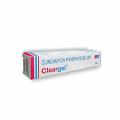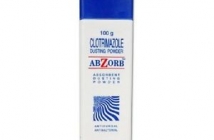Home / Categories / CLINALL LOTION-25ML

CLINALL LOTION-25ML
(1X1)
CLINDAMYCIN-1%W/W
ANTI-ACNE DRUGS
CUTIK MEDICARE
Product Details
Action
Indications
Contraindications
Route/Dosage
Interactions
Lab Test Interferences
Adverse Reactions
PrecautionsPatient Care Considerations
Administration/Storage
Assessment/Interventions
Patient/Family Education
(KLIN-duh-MY-sin)Clindamycin PhosphateCleocin, Cleocin Phosphate, Cleocin T, Clinda-Derm, Clindets, C/T/S,  Dalacin C Phosphate, Dalacin T TopicalClindamycin HydrochlorideCleocinClindamycin Palmitate HydrochlorideCleocin Pediatric, Dalacin CClass: Antibiotic/Lincosamide
Dalacin C Phosphate, Dalacin T TopicalClindamycin HydrochlorideCleocinClindamycin Palmitate HydrochlorideCleocin Pediatric, Dalacin CClass: Antibiotic/Lincosamide
 Action Suppresses bacterial protein synthesis.
Action Suppresses bacterial protein synthesis.
 Indications Treatment of serious infections caused by susceptible strains of specific microorganisms; treatment of acne vulgaris (topical use); treatment of bacterial vaginosis (vaginal use). Unlabeled use(s): Treatment of CNS toxoplasmosis in AIDS patients, Organism: Pneumocystis carinii pneumonia and acute pelvic inflammatory disease; treatment of rosacea (topical).
Indications Treatment of serious infections caused by susceptible strains of specific microorganisms; treatment of acne vulgaris (topical use); treatment of bacterial vaginosis (vaginal use). Unlabeled use(s): Treatment of CNS toxoplasmosis in AIDS patients, Organism: Pneumocystis carinii pneumonia and acute pelvic inflammatory disease; treatment of rosacea (topical).
 Contraindications Hypersensitivity to lincosamides or any product component; treatment of minor bacterial or viral infections; history of regional enteritis, ulcerative colitis or antibiotic-associated colitis.
Contraindications Hypersensitivity to lincosamides or any product component; treatment of minor bacterial or viral infections; history of regional enteritis, ulcerative colitis or antibiotic-associated colitis.
 Route/Dosage
Route/Dosage
ADULTS: PO 150–450 mg q 6 hr. IM/IV 0.6–2.7 g/day divided into 2–4 doses. Do not use > 600 mg in single IM injection. CHILDREN: CLINDAMYCIN HYDROCHLORIDE: PO 8–20 mg/kg/day divided into 3–4 doses. CLINDAMYCIN PALMITATE HYDROCHLORIDE: PO 8–25 mg/kg/day divided into 3–4 doses. CHILDREN > 1 mo: IM/IV 20–40 mg/kg/day divided into 3–4 equal doses. NEONATES < 1 mo: IM/IV 15–20 mg/kg/day divided into 3–4 equal doses.
Acute Pelvic Inflammatory Disease
ADULTS: IV 900 mg q 8 hr with gentamicin. After discharge from hospital continue with doxycycline 100 mg bid for 10 days or oral clindamycin 450 mg 5 times daily for 10–14 days.
Acne
ADULTS: Topical Apply thin film to affected area bid.
Vaginosis
ADULTS: Intravaginal 1 applicatorful preferably at bedtime for 7 days.
 Interactions
Interactions
Erythromycin: May cause antagonism. Kaolin-pectin antidiarrheals: May delay absorption of clindamycin. Nondepolarizing neuromuscular blockers: May enhance actions of blockers. INCOMPATIBILITIES: Ampicillin, phenytoin sodium, barbiturates, aminophylline, magnesium sulfate, calcium gluconate.
 Lab Test Interferences None well documented.
Lab Test Interferences None well documented.
 Adverse Reactions
Adverse Reactions
CV: Hypotension, cardiopulmonary arrest. DERM: Hypersensitivity (eg, skin rash, urticaria, erythema multiforme, some cases resembling Stevens-Johnson syndrome). GI: Diarrhea; colitis, including pseudomembranous colitis; nausea; vomiting; abdominal pain; esophagitis; anorexia. GU: Azotemia; oliguria; proteinuria; cervicitis or vaginitis (with intravaginal form of drug). HEMA: Neutropenia; leukopenia; agranulocytosis; thrombocytopenic purpura. HEPA: Jaundice; liver function test abnormalities. OTHER: Pain after injection; induration and sterile abscess after intramuscular injection; thrombophlebitis after intravenous infusion; anaphylaxis. Topical or vaginal use may theoretically produce adverse effects seen with systemic use as a result of absorption.
 Precautions
Precautions
Pregnancy: Oral, parenteral: Category B. Clindamycin does cross the placenta. Topical, intravaginal: Category B. Lactation: Excreted in breast milk. Children: Monitor organ system functions in newborns and infants; parenteral form may contain benzyl alcohol, which can cause gasping syndrome in premature infants. Colitis: Drug can cause severe and possibly fatal colitis characterized by severe persistent diarrhea, severe abdominal cramps and possibly passage of blood and mucus. Mild cases may respond to drug discontinuation. More severe cases may need fluid, electrolyte and protein supplementation, corticosteroids and other antibiotics. Consider possibility of pseudomembranous colitis. Elderly or debilitated patients: May not tolerate diarrhea well (dehydration). Hypersensitivity: Use drug with caution in patients with asthma or significant allergies. Meningitis: Drug does not diffuse into CSF. Do not use to treat meningitis. Mineral oil: Vaginal cream contains mineral oil, which may weaken latex rubber condoms or diaphragms. Renal or hepatic impairment: Use drug with caution in patients with severe renal or hepatic disease with severe metabolic aberrations. Tartrazine sensitivity: Some products contain tartrazine, which may cause allergic-type reactions in susceptible individuals.
PATIENT CARE CONSIDERATIONS
 Administration/Storage
Administration/Storage
- Administer capsules with full glass of water or with food.
- Give via deep IM injection. Do not administer more than 600 mg in single IM injection. Rotate injection sites.
- For IV infusion, dilute in 50–100 ml D5W or normal saline and infuse over 1 hr. Concentration should not exceed 18 mg/ml.
- Administer over 10–60 min (not to exceed 30 mg/min). Do not infuse as intravenous bolus.
- Do not infuse more than 1200 mg in 1 hr.
- Do not apply topical solution to abraded skin or mucous membranes.
- Keep vaginal cream and topical solution out of eyes.
- Store reconstituted clindamycin palmitate (pediatric oral solution) at room temperature for up to 2 wks. Do not refrigerate (causes thickening).
 Assessment/Interventions
Assessment/Interventions
- Obtain patient history, including drug history and any known allergies. Check for renal or hepatic impairment, GI disease, asthma or significant allergies.
- When administering drug to newborns or infants, monitor organ system functions.
- With long-term therapy monitor liver and kidney function tests and blood counts.
- Report symptoms of colitis (severe diarrhea, severe abdominal cramps, passage of blood or mucus) to physician immediately. Symptoms may occur up to several wk after cessation of therapy.
- Be alert for the possibility of bacterial or fungal overgrowth on nonsusceptible organisms, especially yeasts.
 Patient/Family Education
Patient/Family Education
- Advise patient to take capsules with full glass of water or with food.
- Instruct patient using vaginal cream not to engage in sexual intercourse during treatment.
- Advise patients using vaginal cream that if they do engage in sexual intercourse not to use rubber or latex birth control devices (condoms, cervical caps or diaphragms) for 72 hr after treatment. Vaginal cream contains mineral oil, which may weaken latex rubber condoms or diaphragms.
- Teach patient to be careful to keep vaginal cream and topical solution out of eyes.
- Instruct patient not to apply topical solution to abraded skin or mucous membranes.
- Advise patient to notify physician if hypersensitivity reaction occurs (skin rash, urticaria, erythema multiforme) or if symptoms of disease being treated worsen.
- Instruct patient to notify physician if diarrhea develops; patient should not try to treat with otc medications. (Taking Lomotil [diphenoxylate compound] may prolong and worsen diarrhea.)
Books@Ovid
Copyright © 2003 Facts and Comparisons
David S. Tatro
A to Z Drug Facts








